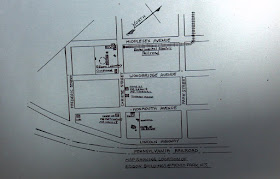Most people don't realize this, but Edison was one of many innovators whose work and patents influenced the electric railways we know today. In fact, he built Menlo Park's first electric train system back in 1880, long before the Pennsylvania Railroad erected the catenary wires that power the trains that now stop at the nearby Metropark Station.
Edison's connection with railroads stretches back to his childhood, when he sold sundries on the Grand Trunk lines in his native Michigan. His interest in using electricity as a power source for trains, however, seems to have come more from his desire to make electric distribution economical. With the perfection of the light bulb came the need for electricity to power it, and by extension, a distribution system to bring electricity from a central generator to the customer. Lighting would be used mostly at night, meaning that generation and distribution equipment would go mostly unused during the day.
 |
| The route of Edison's Menlo Park railroad |
The maiden run of the Edison railroad took place on May 13, 1880, when the Old Man himself took control of the locomotive. As Francis Jehl, one of Edison's assistants, later recalled in Menlo Park Reminiscences, many of the muckers gathered onto the bench-laden open-air passenger car to be part of the history-making trip.
"... [A]s many of the 'boys' as could find foothold crowded on -- about twenty in all... The current was switched on, and amid cheers, hurrahs and the waving of hats and handkerchiefs, the little train started up.... The locomotive picked up speed and we all glided along to the end of the line with excitement and buoyant hopes."The locomotive ran well in drive but the return trip faced some glitches. "When the order 'all aboard' was given for the return trip," Jehl recounted, "Batchelor applied the lever so violently that one of the friction wheels burst and disabled the locomotive." Edison ordered design adjustments to the transmission and the team began work anew. By the time the second run took place, the train included two additional cars to carry freight and a newly-patented braking system. The train's generator was the first of its kind to work at 90 percent efficiency.
 |
| The railroad 'right of way' in 2013, now the site of homes, lawns and woods. |
Brilliant though Edison was, his railroad was yet another example of where he neglected to explore other possible applications of his ideas. He was so focused on his original concept -- moving freight -- that it took a long time before he saw the benefits of applying electric power to passenger transportation like streetcars. While we can't look on Edison as the father of the electric railway, his improvements led to several patents and innovations like an electrified third rail to power underground systems.
The tracks of Edison's Menlo Park railway are long gone, but an informative wayside display across from the Christie Street museum and memorial tower offers perspective on the events that took place there. The trucks (or wheels) of the second electric locomotive are on view on the Main Street side of the Thomas Edison National Historical Park in West Orange.
Edison's connection with railroads stretches back to his childhood, when he sold sundries on the Grand Trunk lines in his native Michigan. He was actually born in Milan Ohio but spent his youth in MI.
ReplyDelete